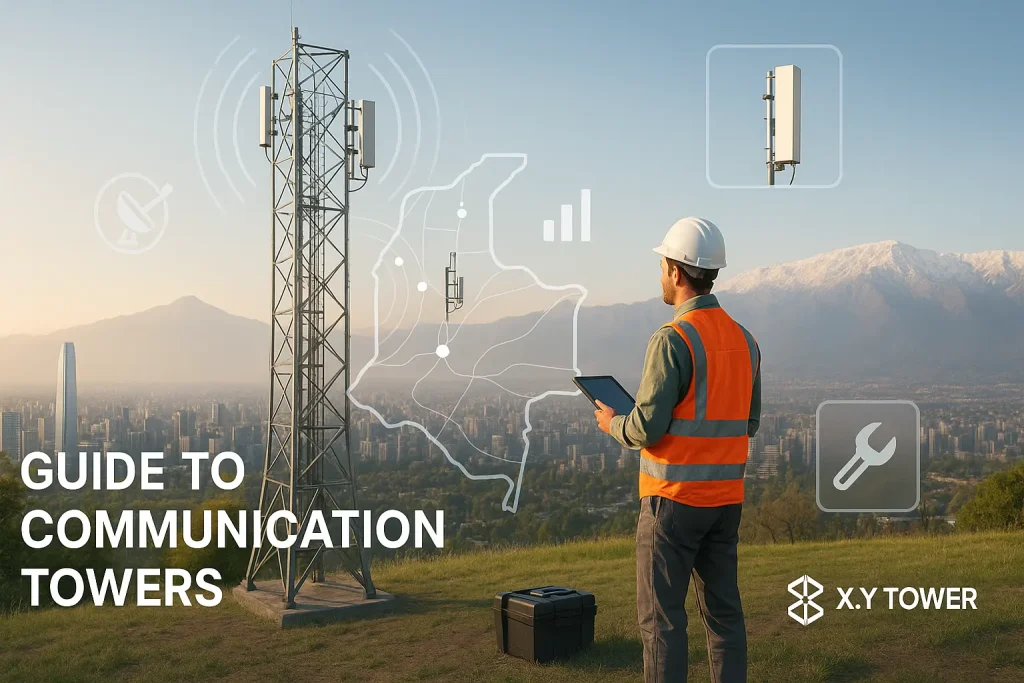Guide to Communication Towers in Chile
2025-09-25
A communication tower in Chile is a critical piece of modern infrastructure. Chile is defined by its unique geography. It is a long, narrow country with incredibly diverse climates. These range from the world's driest desert in the north to glacial regions in the south. This geography presents distinct challenges for telecom network development. As one of Latin America's most stable and connected economies, Chile demands a high-quality, resilient network. Infrastructure partners must provide advanced engineering and durable structures. A leading supplier understands these unique conditions. They build the foundation for a robust and future-proof telecommunications system.

Key Market Drivers for Tower Development in Chile
The demand for a communication tower in Chile is driven by several key factors. The country is a regional leader in technology adoption. Its government and private sector are committed to maintaining a first-class digital infrastructure. This commitment fuels continuous investment in the network. Understanding these drivers is essential to understanding the dynamics of the Chilean tower market. They explain the ongoing need for new sites and technological upgrades across the nation.
Early and Ambitious 5G Deployment
Chile was one of the first countries in Latin America to launch a nationwide 5G network. This ambitious rollout is a primary driver for the market. The deployment of 5G requires a denser network of sites. It also necessitates upgrades to existing towers to support new, heavier antennas. This technological transition is fueling a significant wave of investment. A provider of a communication tower in Chile must be able to meet the demanding technical specifications of 5G. This leadership in 5G sets the pace for the entire region.
Connectivity for Key Economic Industries
Chile's economy is powered by key industries like mining, agriculture, and aquaculture. These sectors are increasingly reliant on digital technology. The mining industry, located in the remote Atacama Desert, uses autonomous vehicles and IoT sensors. Agriculture in the central valley uses precision farming techniques. Aquaculture in the south requires remote monitoring. A communication tower in Chile provides the vital connectivity for these modern industrial operations. This demand for coverage in remote economic zones is a steady driver of growth.
Bridging the Digital Divide
The Chilean government is strongly committed to bridging the digital divide. There are ongoing initiatives to bring high-speed internet to rural, remote, and isolated communities. This includes parts of the Andes mountains and the southern Patagonia region. Building a communication tower in Chile's remote areas is a key part of this strategy. These projects, often supported by government funds, expand the reach of the mobile network. They provide essential services and opportunities to all citizens, regardless of their location.
Environmental and Engineering Challenges in Chile
Building a communication tower in Chile requires overcoming formidable environmental and engineering challenges. The country's geology and diverse climates create a uniquely demanding operational landscape. A successful infrastructure provider must possess highly specialized expertise. These challenges influence every aspect of tower development, from material selection to foundation design. Mastering these challenges is a prerequisite for any company operating in the Chilean market.
Critical Need for Seismic Engineering
Chile is located on the Pacific Ring of Fire. It is one of the most seismically active countries in the world. Major earthquakes are a regular occurrence. Therefore, every communication tower in Chile must be designed to withstand extreme seismic events. This is the single most important engineering consideration. It requires sophisticated structural analysis and foundations designed for seismic resilience. The standards for seismic engineering in Chile are among the strictest in the world. This expertise is similar to the requirements for a communication tower Mexico City but is a constant focus for all national infrastructure.
Designing for Extreme and Varied Climates
The climate in Chile varies dramatically from north to south. In the Atacama Desert, a communication tower in Chile must withstand intense solar radiation and extreme temperature fluctuations. A leading provider must use materials and designs tailored to each specific climate zone. This requires a deep understanding of material science and environmental engineering.
Logistical Challenges of Geographic Isolation
Chile's long, thin shape and mountainous terrain create significant logistical challenges. Transporting tower components to remote mining sites or isolated southern communities is a complex operation. It requires careful planning and specialized transportation. Access roads can be limited or non-existent. A top provider of a communication tower in Chile must have a strong and agile logistics network. They need to be able to deliver materials and equipment to some of the most remote places on the continent. These challenges are in some ways similar to those faced when deploying a telecom tower Colombia.
A Well-Defined Regulatory Framework
The telecommunications sector in Chile is regulated by the Subsecretaría de Telecomunicaciones (SUBTEL). The regulatory framework is well-defined and stable. While this provides clarity, the process for obtaining permits for a new communication tower in Chile is rigorous. It involves environmental impact assessments and adherence to strict technical standards. An experienced provider has a deep understanding of this regulatory process. They can navigate it efficiently to ensure projects are approved in a timely manner.
The Structure of the Chilean Tower Market
The market for a communication tower in Chile is mature and highly structured. It is a competitive environment characterized by the strong presence of independent tower companies. These towercos own and manage the majority of the country's passive telecom infrastructure. This market structure promotes efficiency and rapid network deployment. Understanding the roles of the various players is essential to understanding the industry's dynamics.
The Established Presence of Independent Towercos
Independent tower companies are the dominant players in the Chilean market. They own large portfolios of towers and lease space to multiple mobile network operators. This tower-sharing model is the industry standard. It allows operators to expand their networks with lower capital costs. These towercos are the primary clients for companies that manufacture and install towers. A provider of a communication tower in Chile must focus on meeting the needs of these large, sophisticated infrastructure owners. This is a common model seen across the region, making cell tower installation Latin America a key area of expertise.
A Highly Competitive MNO Landscape
The mobile market in Chile is one of the most competitive in Latin America. Major operators are in a constant battle for market share. This fierce competition drives them to continually improve their network quality and coverage. The plans of these mobile network operators are the ultimate source of demand for new tower sites. Their aggressive 5G rollout plans are a key reason for the market's current dynamism. A provider of a communication tower in Chile must be able to support this fast-paced competitive environment.
The Ecosystem of Suppliers and Partners
A network of international suppliers and local partners supports the tower industry. Global manufacturers provide the advanced steel towers and antenna systems. They bring international quality standards and the latest technology to the market. These global firms often work with local engineering and construction companies. These local partners provide the essential on-the-ground expertise needed to execute projects. The ability to manage this ecosystem is a key skill for any provider of a communication tower in Chile. This collaborative model is also seen in the market for a communication tower Peru.
The Push for Infrastructure Sharing and Efficiency
There is a strong emphasis on efficiency in the Chilean market. Infrastructure sharing is not limited to towers. There are also initiatives for sharing active network components and fiber optic cables. This focus on efficiency drives towercos and operators to seek the most cost-effective solutions. A provider of a communication tower in Chile must offer designs that are optimized for multi-tenancy. They must also provide solutions that are cost-effective to build and maintain over the long term. This focus is similar to what is required of a telecom tower supplier São Paulo.
Technological Innovations and Future Trends
The technology associated with a communication tower in Chile is continually advancing. Innovation is driven by the demands of 5G, the need for sustainability, and the challenges of the local environment. A leading provider must be at the forefront of these technological trends. They need to offer solutions that are resilient, efficient, and prepared for the future. These trends are shaping the next generation of telecom infrastructure in Chile.
Advanced 5G Antenna Hosting Requirements
The deployment of 5G and its advanced antenna systems, like Massive MIMO, creates new requirements for towers. These antennas are heavier and have a larger surface area. A communication tower in Chile must be designed or retrofitted to handle these increased loads. This requires precise structural engineering and analysis. Providers must offer solutions that can host this complex 5G equipment safely and efficiently.
The Growing Importance of Renewable Energy
Sustainability is a major focus in Chile. The country is a world leader in renewable energy, particularly solar power. There is a strong push to power telecom sites with clean energy. A leading provider of a communication tower in Chile must have expertise in renewable power solutions. This is especially important for off-grid sites in mining areas or remote regions. Key components of these systems include:
- High-Efficiency Solar Panels: Optimized for the intense solar radiation in northern Chile.
- Advanced Battery Storage: Lithium-ion batteries to store energy for use at night.
- Hybrid Control Systems: Intelligent controllers that manage the flow of energy between solar, batteries, and a backup generator.
- Wind Turbines: In some southern regions, small wind turbines can supplement solar power.
Diverse Tower Types for Different Terrains
The varied geography of Chile requires a range of tower designs. A single type of tower is not suitable for all locations. A comprehensive provider of a communication tower in Chile offers a portfolio of different structures. This includes heavy-duty lattice towers for industrial sites in the north. It includes slim monopoles for urban areas like Santiago. It also includes guyed masts for cost-effective coverage in rural valleys.
Remote Monitoring and Drone Inspections
Managing a vast and geographically dispersed portfolio of towers is a major challenge. Technology is providing new tools to make this more efficient. Remote monitoring systems allow companies to track the status of each communication tower in Chile in real-time. Drones are also being used for site inspections. A drone can safely and quickly inspect a tower for any structural damage or maintenance needs. This technology reduces costs and improves the safety and reliability of the network.
Conclusion
The market for a communication tower in Chile is one of the most advanced and demanding in Latin America. It is characterized by the country's early adoption of 5G and its formidable geographical and geological challenges. The industry is defined by its rigorous engineering standards, particularly for seismic resilience. It is a competitive market dominated by efficient towercos and served by a mix of global and local expertise. The future will be shaped by the continued expansion of 5G and a strong focus on sustainable technologies. A leading provider of a communication tower in Chile must be a master of advanced engineering, complex logistics, and regulatory compliance. They are essential partners in maintaining Chile's position as a leader in digital connectivity.

Hey, I’m Chunjian Shu
"X.Y. Tower: Reliable, innovative solutions for high-quality towers and electrical equipment with professional service.
